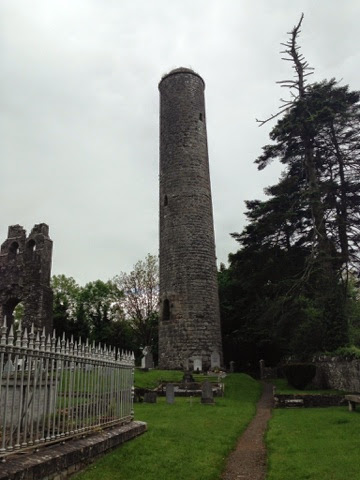There are 3 great passage tombs in the Bru Na Boinne Valley: Knowth, Newgrange, and Dowth. The area known as Bru Na Boinne is a UNESCO-designated World Heritage Site, and is considered one of the world's most significant archeological finds.
Steve and I have been quite awed by the Passage Tombs, and decided it was time to see the third, lesser known, passage tomb in the Bru Na Boinne (Boyne) Valley. So, after Monasterboice, we headed on to Dowth.
When we first tried to find the entrance to Dowth, we came upon this estate. We could not access the drive as it was gated and locked. It appeared to be a private residence, but in looking up information about it, it would seem that it may either sit empty or has been recently renovated to be run as a guest house. I am not sure, as there were no signs indicating that one could try to book it as a guest house.
Anyway, from what I can gather, this is Dowth Manor which belonged to the Netterville family. According to the web site www.nci.ie, Hugh DeLacy granted the medieval castle to the Netterville family in the 13th century. In 1641 Viscount Nicholas Netterville was declared an outlaw by the Crown, and he was deprived of his estates until he was pardoned 10 years later by Oliver Cromwell's Government.
The Sixth Viscount John Netterville, built Dowth Hall in the mid 18th century. He moved into the hall in 1780 and let the Castle to fall into disrepair. He built a tea house on top of the nearby Dowth Mound where he reputedly attended mass using a telescope from that vantage point to view a nearby church. He died in 1826 and left the Castle to be used as an alms house for aged women.
The Netterville House was apparently built in 1877 according to the web site noted above.
Dowth is not built up for tourism, but it is as large as the other two.
Dowth was constructed in the Stone Age, about 5000 years ago and is
surrounded by 115 kerb stones. It suffered a lot of damage when a group was searching for the Ark of the Covenant and attempted to excavate the site. Unfortunately, they used dynamite and left a large crater in the top of the mound. I am not sure if the passages are really considered safe now, and they are locked off so you can't enter, though I believe one can contact OPW to see about being able to tour part way into the passages with a guide.
This is the story of how the Mound got it's name.
This diagram shows you where Knowth, Newgrange and Slane are in relation to Dowth.
In the distance here I think is Knowth.
This is the Stone of the Seven Suns:
Sheep and Goat...Yes, you have to step with care....
This is how close the mound is to the Manor. In the distance you can see Newgrange.
Below you can see the Hill of Slane in the distance. That is where we were the day before.
The crater left in the mound. Those stones are just exposed, they are not one of the entrances.
I am not sure what is the story of the circle of stones.
Dowth had this feel to it that was wild and untouched (except for that dynamite crap...) but it was amazing to be there, just me and Steve, walking around an ancient passage tomb with no other sound except the sheep and the goats. The views are amazing, though we didn't take the opportunity to look for a mass to attend! It is worth the drive, and it is, of course, free.


























































